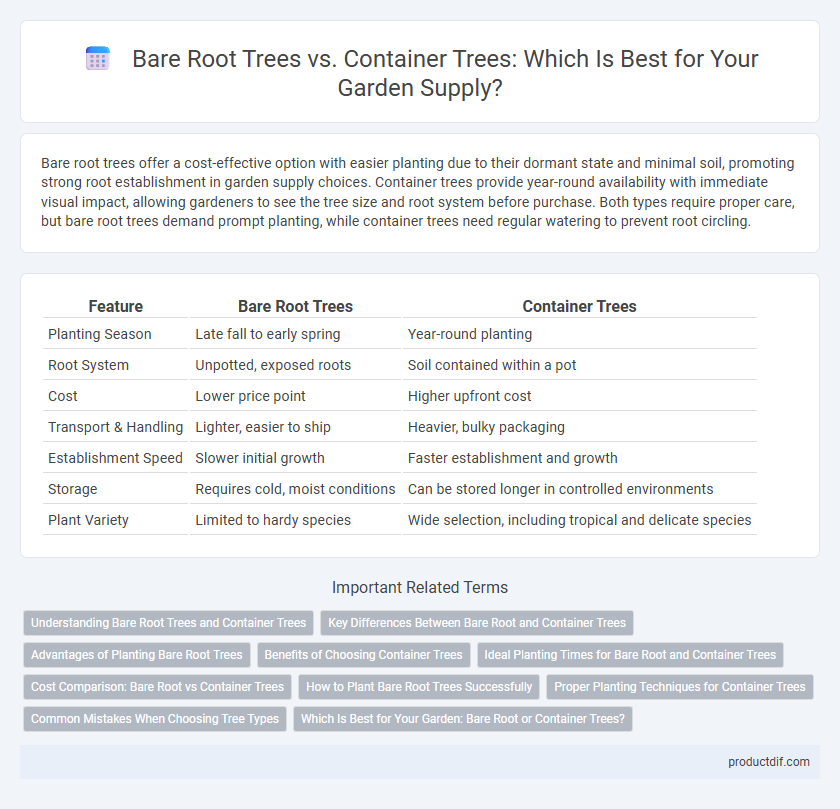Bare root trees offer a cost-effective option with easier planting due to their dormant state and minimal soil, promoting strong root establishment in garden supply choices. Container trees provide year-round availability with immediate visual impact, allowing gardeners to see the tree size and root system before purchase. Both types require proper care, but bare root trees demand prompt planting, while container trees need regular watering to prevent root circling.
Table of Comparison
| Feature | Bare Root Trees | Container Trees |
|---|---|---|
| Planting Season | Late fall to early spring | Year-round planting |
| Root System | Unpotted, exposed roots | Soil contained within a pot |
| Cost | Lower price point | Higher upfront cost |
| Transport & Handling | Lighter, easier to ship | Heavier, bulky packaging |
| Establishment Speed | Slower initial growth | Faster establishment and growth |
| Storage | Requires cold, moist conditions | Can be stored longer in controlled environments |
| Plant Variety | Limited to hardy species | Wide selection, including tropical and delicate species |
Understanding Bare Root Trees and Container Trees
Bare root trees are sold without soil, typically during dormancy, allowing easier transport and deeper root inspection, which promotes faster establishment in the garden. Container trees grow in pots filled with soil or growing medium, providing continual root protection and the ability to plant year-round. Understanding these differences helps gardeners choose the best option for planting time, site conditions, and long-term tree health.
Key Differences Between Bare Root and Container Trees
Bare root trees arrive dormant without soil, making them lighter, less expensive to ship, and easier to plant in early spring compared to container trees, which come potted in soil and can be planted throughout the growing season. Bare root trees establish faster and develop stronger root systems but require well-prepared planting sites with immediate planting to prevent root drying, unlike container trees that retain moisture and are more adaptable to various planting times. The choice between bare root and container trees influences planting strategies, costs, and tree establishment success significantly in garden supply and landscaping projects.
Advantages of Planting Bare Root Trees
Planting bare root trees offers significant advantages including lower cost and easier transportation due to their dormant state and lack of soil. Bare root trees tend to establish deeper root systems faster as their roots have direct soil contact, promoting healthier growth and enhanced drought resistance. Moreover, bare root trees allow for a broader selection of species and sizes during planting season, providing gardeners with more flexibility and choice.
Benefits of Choosing Container Trees
Container trees offer immediate planting flexibility, allowing gardeners to plant year-round regardless of season, unlike bare root trees which have limited planting windows. These trees maintain a well-developed root system enclosed in soil, promoting faster establishment and reducing transplant shock. Container trees also provide a wider selection of varieties and sizes, making them ideal for customized landscaping projects.
Ideal Planting Times for Bare Root and Container Trees
Bare root trees are ideally planted during their dormancy period in late winter to early spring, ensuring minimal stress and optimal root establishment before growth begins. Container trees offer more flexibility and can be planted throughout the growing season, but early spring or fall planting is recommended for best root development and acclimation. Choosing the correct planting time for each type maximizes tree health and long-term growth success in garden landscapes.
Cost Comparison: Bare Root vs Container Trees
Bare root trees typically cost less than container trees due to lower shipping and storage expenses, making them an economical choice for large-scale planting projects. Container trees often have higher upfront costs because they come with established root systems and are sold year-round. Selecting bare root trees can reduce initial investment but may require more careful handling during planting to ensure successful establishment.
How to Plant Bare Root Trees Successfully
To plant bare root trees successfully, soak the roots in water for 12 to 24 hours before planting to rehydrate them thoroughly. Dig a wide, deep hole that allows the roots to spread naturally without bending or crowding, ensuring the graft union remains above soil level. Backfill with native soil, water deeply to eliminate air pockets, and apply mulch to retain moisture and regulate soil temperature for optimal growth.
Proper Planting Techniques for Container Trees
Proper planting techniques for container trees involve selecting a suitable location with well-draining soil and ample sunlight to support healthy growth. It is essential to gently remove the tree from its container, loosen the root ball, and plant it at the same depth it was growing in the container to prevent root rot. Water the tree thoroughly after planting, mulch around the base to retain moisture, and monitor regularly to ensure proper establishment and prevent stress.
Common Mistakes When Choosing Tree Types
Choosing bare root trees during the wrong planting season causes root drying and reduces survival rates, while improper handling of container trees can lead to root circling and stunted growth. Many gardeners underestimate the importance of soil preparation and drainage, which critically affect both tree types' establishment and long-term health. Selecting container trees without checking root ball moisture often results in transplant shock, adversely impacting initial growth and vigor.
Which Is Best for Your Garden: Bare Root or Container Trees?
Bare root trees offer a cost-effective option with easier transplanting and quicker root establishment, making them ideal for larger landscaping projects or dormant season planting. Container trees provide flexibility with year-round availability and lower transplant shock due to their established root systems, suitable for immediate planting and smaller garden spaces. Choosing between bare root and container trees depends on your garden's size, planting season, and long-term growth goals.
Bare Root Trees vs Container Trees Infographic

 productdif.com
productdif.com